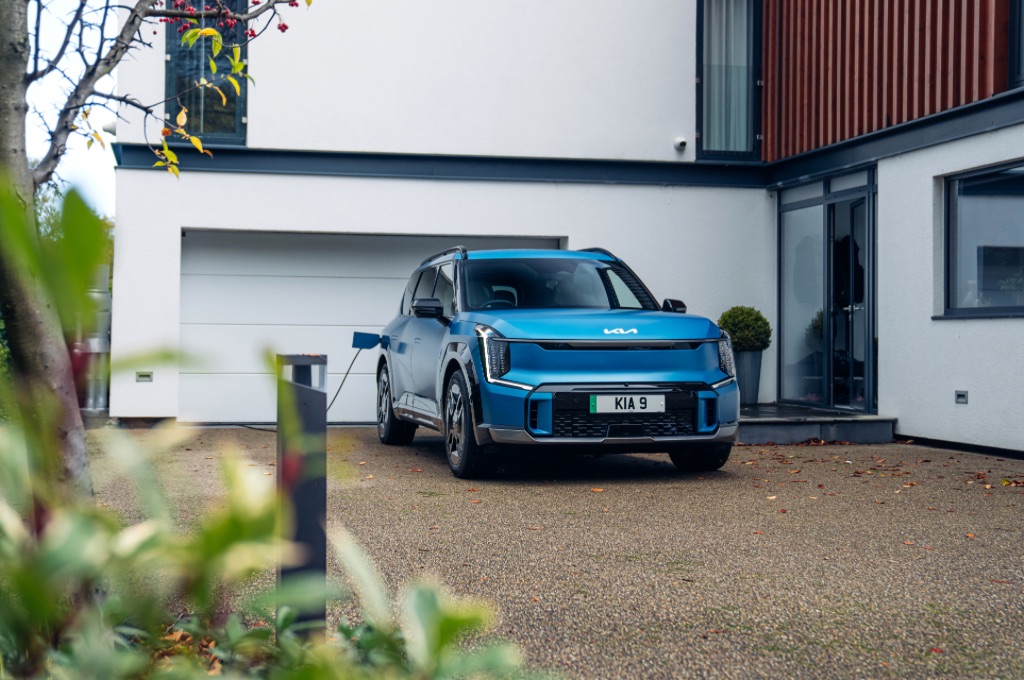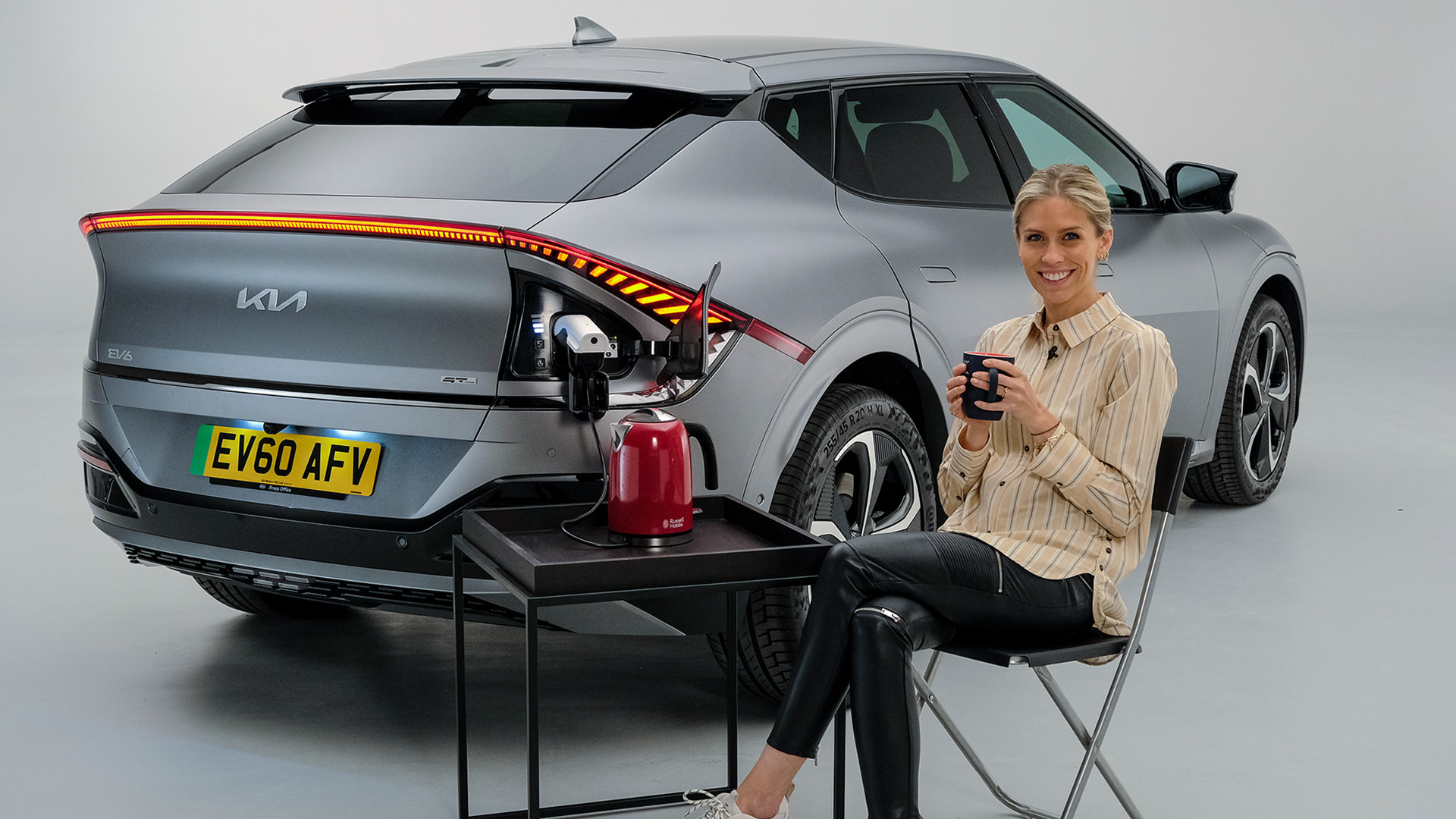Bi-directional charging is one of those phrases that you may well have stumbled across if you’re thinking of buying an electric car, but it’s not always that obvious what it means. Especially because it can mean lots of different things. Fear not, we’ve busted the jargon for you, so read on to find out everything you need to know about bi-directional charging.
What does bi-directional charging mean?
It means that you can charge things from your electric car’s high voltage battery. For instance, you could park your car at your allotment and run an electric mower or strimmer off the car’s battery. Or you could plug a portable fridge into the car when you’re camping, or plug in your laptop for some working on-the-go… If it’s an electric device, and your car has ‘bi-directional’ charging, you can charge that device from your car’s battery. And don’t worry, electric cars with this feature also allow you to set a minimum battery charge level, so that you can be sure that there’ll be enough charge left in the car to get you home.
Where it gets confusing is that ‘bi-directional charging’ is often used to refer specifically to electric cars that can send power back into your home or the power grid, but it can also cover a variety of other functions – and not all cars that are described as having bi-directional charging will be able to do all of the charging wizardry described here. So, do pay attention to the anacronyms, as an electric car with V2D may not have V2G… And if you’re wondering what on earth that means, read on…
Vehicle-to-grid (V2G)
This is where an electric vehicle can send power directly back into the power grid. It’s a very useful feature that is likely to become very important in the future, because it means that the power grid can ‘borrow’ electricity from any electric cars that are plugged in and aren’t in use, when demand is very high. So, when everyone gets home in early evening and puts the kettle on, the grid sees a big surge in demand. As more electric cars start to offer bi-directional V2G charging, the electric car can actually help to support the grid when demand is high – and then your car can simply charge up overnight when demand is low. Clever stuff.
You can actually earn money by selling electricity back to the grid, too, but this makes most sense if you’ve got solar panels at home so that you can actually generate your own electricity to charge your car – and sell power back to the grid.
The big problem, currently, is that you do need a bi-directional V2G home charger to support V2G bi-directional charging. Unfortunately, these are still only available on a trial basis, and it’ll be a while before they become available on the mainstream market.
Vehicle-to-home (V2H)
This is where your car’s battery powers your home. This is, again, beneficial for reducing the demand on the power grid at peak times. It can also be a huge benefit for anyone with solar panels, who can then effectively use the electric car as a storage battery - charging the vehicle from the solar panels, and then using that stored energy to power the house at night or when it’s not very sunny. And yes, the average electric car has more than enough battery capacity to run your house – and still have a useful driving range left over. The average house in the UK uses around 7- to 8kWh of electricity per day, so an electric car with a 50kWh battery could potentially power your house for 24 hours, and still have 150-odd miles of range left over.
As with V2G charging, the problem here is that you need a bi-directional home charger, which are not yet widely available. The tech is there already, and there are bi-directional electric cars already on sale that support V2G and V2H, but it’s slow progress with government-mandated safety legislation regards installation of these advanced, two-way V2H/V2G home chargers.

Vehicle-to-load (V2L)
This is becoming fairly common in a lot of electric cars, and all it means is that you can power your electrical devices – or even another electric car – from your electric vehicle’s high voltage battery pack. Kia, Hyundai, MG and Volkswagen all offer cars with V2L functionality. The MG4, for instance, comes with a V2L adaptor that you plug into the car’s charging socket, and then you plug your lawn mower/fridge/power tool into the adaptor. The Kia Niro EV and Hyundai Kona have three-pin sockets in the rear seat base, so that you can literally just plug your laptop or other device in, just as you would with a socket in the wall at home.
You get a similar charge rate from these electric car V2L sockets as you do from the sockets in your house, too (around 2.3kW). So, if you are using the V2L function for vehicle-to-vehicle (V2V) charging, keep in mind that it’ll be a very slow charge. You’ll only get around five- to eight miles of additional range per hour, into the car that you’re charging.

Vehicle-to-device (V2D)
This is simply another way of describing vehicle-to-load (V2L) tech that we’ve just explained above. Same tech, different anacronym.
Vehicle-to-vehicle (V2V)
This is just where you use one electric car with V2L, to charge another electric car – as we describe above.
Vehicle-to-X
We threw this in just to keep you on your toes… Vehicle-to-X (V2X) is used to describe how a car – electric or otherwise – might communicate wirelessly with anything else. As in ‘Vehicle-to-everything’, hence Vehicle-to-X. When your car communicates with other cars to update the nav with live traffic information, that’s V2X. It has nothing to do with charging. But, just in case you’re lost in a world of acronyms and this one crops up, it isn’t anything that you need to worry about.
Which cars have bi-directional charging?
Volkswagen, Cupra, Nissan, Kia, Hyundai and BYD all have cars that support bi-directional charging. Nissan has run pilot schemes with the Nissan Leaf supporting vehicle-to-home charging, the Cupra Born has also been used in trials with the Quasar 2 smart home charger (a bi-directional home wallbox that is in production already) to successfully support V2G and V2H. There is even a V2G tariff; the Octopus Power Pack tariff is still in ‘Beta’ testing, but it enables an electric car driver to sell power back to the grid, and could potentially save as much as £880 compared with the utility provider’s standard tariff.
When will bi-directional charging be available in the UK?
There’s no definite answer to that, yet. The technology is ultimately already there from vehicle- and charger manufacturers, but implementing the legislation that will govern the installation and usage of these systems is a slow process. Making the technology affordable is also going to take some time. For now, it seems certain that bi-directional charging will become a huge part of life with electric cars – whether you’re powering your house, selling power to the grid, or just strimming your allotment, it’s technology that stands to benefit everyone. We’ve got everything crossed that it won’t be long before it becomes attainable for every electric car driver.





.png)





